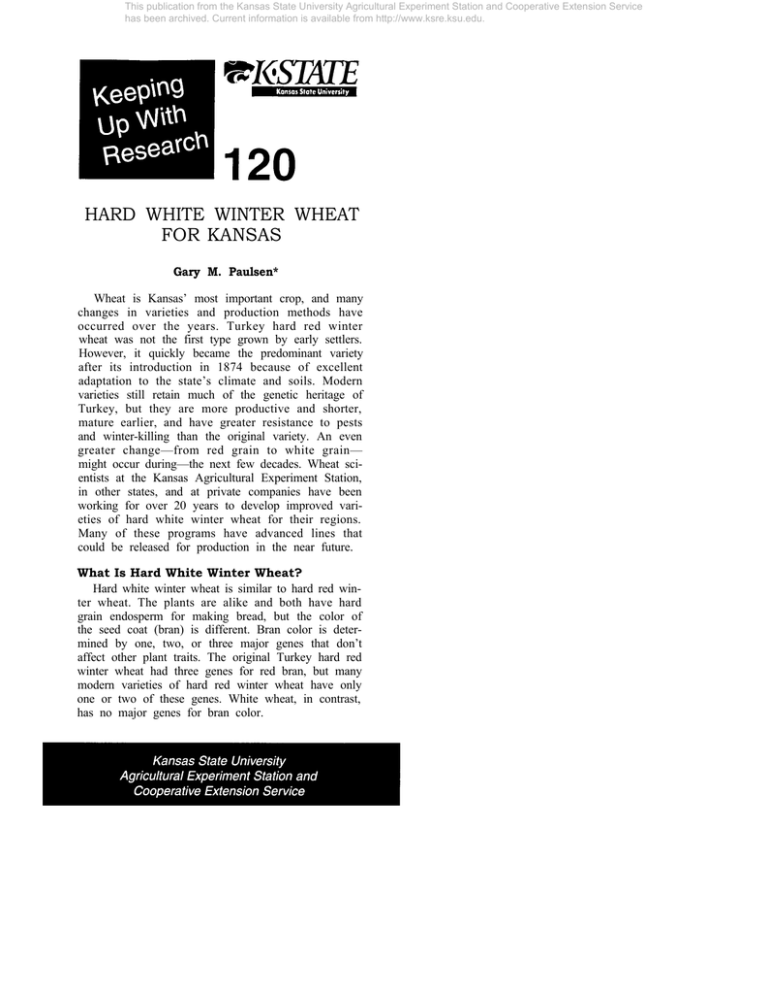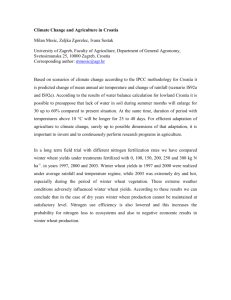
This publication from the Kansas State University Agricultural Experiment Station and Cooperative Extension Service
has been archived. Current information is available from http://www.ksre.ksu.edu.
HARD WHITE WINTER WHEAT
FOR KANSAS
Gary M. Paulsen*
Wheat is Kansas’ most important crop, and many
changes in varieties and production methods have
occurred over the years. Turkey hard red winter
wheat was not the first type grown by early settlers.
However, it quickly became the predominant variety
after its introduction in 1874 because of excellent
adaptation to the state’s climate and soils. Modern
varieties still retain much of the genetic heritage of
Turkey, but they are more productive and shorter,
mature earlier, and have greater resistance to pests
and winter-killing than the original variety. An even
greater change—from red grain to white grain—
might occur during—the next few decades. Wheat scientists at the Kansas Agricultural Experiment Station,
in other states, and at private companies have been
working for over 20 years to develop improved varieties of hard white winter wheat for their regions.
Many of these programs have advanced lines that
could be released for production in the near future.
What Is Hard White Winter Wheat?
Hard white winter wheat is similar to hard red winter wheat. The plants are alike and both have hard
grain endosperm for making bread, but the color of
the seed coat (bran) is different. Bran color is determined by one, two, or three major genes that don’t
affect other plant traits. The original Turkey hard red
winter wheat had three genes for red bran, but many
modern varieties of hard red winter wheat have only
one or two of these genes. White wheat, in contrast,
has no major genes for bran color.
This publication from the Kansas State University Agricultural Experiment Station and Cooperative Extension Service
has been archived. Current information is available from http://www.ksre.ksu.edu.
Hard white wheat is not a new crop. Farmers in
China, the major wheat producer in the world and an
important customer for U.S. wheat, grow white
wheat varieties in areas with suitable climate.
Australia, a major competitor of U.S. wheat on the
world markets, grows only hard white spring wheat
varieties, some of which make excellent Orientalstyle noodles as well as baked products. In Kansas,
small amounts of hard white winter wheat are grown
by producer associations. Other classes of white
wheat are grown in California, Michigan, New York,
and the Pacific Northwest.
Advantages of White Wheat
Many good reasons support considering production of hard white winter wheat instead of hard red
winter wheat in Kansas. The most important reason
is that customers, from the miller to the baker to the
consumer, prefer white wheat whenever they have a
choice. This preference is particularly strong in foreign markets, which purchase one-half to two-thirds
of the wheat produced in Kansas.
Researchers at the Kansas Agricultural Experiment
Station were aware of several advantages of hard
white winter wheat when they started the project.
White grain can be milled at a slightly higher extraction rate to yield more flour than red grain, making
each bushel of white wheat more valuable. The higher
extraction rate often increases the flour’s content of
protein, an essential component for bread making.
The flour also has a better color score, a measure of
flour quality used by some countries. Products baked
from whole wheat flour, which are popular in the U.S.
and overseas, or from flour milled at a high extraction
rate (as required by some foreign governments) have
a more pleasing appearance when they are made
from white grain instead of red grain. As one
researcher stated, “people eat with their eyes.”
Finally, researchers recognized the possibility that the
bran, long considered a by-product of the milling of
red wheat, would be a valuable co-product for breakfast cereals when it came from white wheat.
Additional advantages of white wheat were discovered by other researchers as the project progressed.
A recipe for bread dough was found to require less
sugar when it was made with white wheat flour
instead of red wheat flour. This difference would have
important economic and nutritional benefits. Taste
panels comparing various baked products always preferred those from white wheat over those from red
wheat. The reason for this preference for white
wheat products isn’t known, but it is suspected to be
related to the absence of chemical pigments that give
red wheat its color.
Development of the New Crop
Development of hard white winter wheat was
started by the late Dr. Elmer G. Heyne, who was
leader of the wheat breeding project at Kansas State
University in Manhattan. During a sabbatical leave in
Australia during the late 1960s he recognized that
conditions might be even more favorable in Kansas
than in Australia for production of white wheat.
Other scientists in the Kansas Agricultural
Experiment Station joined him to study the agronomic, grain quality, and economic problems of
introducing the new type of wheat in the state. They
quickly found that hard white winter wheat was
highly adapted, the grain quality was advantageous,
and the economics were favorable. However, serious
problems remained in producing white wheat, developing varieties that had desirable characteristics,
learning all the potential uses of the grain, and introducing the new class into a system that was structured for hard red winter wheat.
The major production problem for hard white winter wheat is susceptibility of the grain to preharvest
sprouting. Rain, high humidity, and low temperatures
after ripening cause white grain to sprout in the
spike. Although white grain is more susceptible to
preharvest sprouting than red grain, even some varieties of hard red winter wheat sprout in the field. This
occurred over wide areas of Kansas in 1979 and
1989. Preharvest sprouting destroys the breadmaking ability of wheat and leaves the grain fit only for
livestock feed.
Resistance to preharvest sprouting once was
attributed to the pigment for grain color in red wheat;
because white wheat lacked the pigment, it could not
resist sprouting. This theory was disproved when several sources of genetic resistance to preharvest
sprouting were discovered in white wheat, including
one in Kansas. Mr. Earl G. Clark, a wheat breeder
and farmer in Sedgewick, Kansas, developed many
famous varieties of hard red winter wheat during the
first half of the century. He routinely left his experimental wheats standing in the field for 2 months after
they ripened and, by repeated selection, also developed a hard white winter wheat, Clark’s Cream, that
was highly resistant to preharvest sprouting.
Researchers at the Kansas Agricultural Experiment
Station transferred the excellent sprouting resistance
in Clark’s Cream to improved experimental lines,
which were released for use by other wheat breeders
in 1988.
The use of resistant varieties and prompt harvest
should minimize the problem of preharvest sprouting
in Kansas. Weather in the major wheat areas of central and western Kansas during June, when wheat
This publication from the Kansas State University Agricultural Experiment Station and Cooperative Extension Service
has been archived. Current information is available from http://www.ksre.ksu.edu.
ripens, is usually unfavorable for preharvest sprouting. Production in eastern Kansas, where the rainfall
and humidity are higher, might be discouraged until
varieties with high levels of sprouting resistance are
available.
New wheat varieties must be well adapted, high
yielding, and resistant to pests and adverse weather
conditions and produce quality grain. Combining all
of these traits into a new variety is a long process.
Established breeding programs for hard red winter
wheat usually take 10 years or longer to develop a
new variety. The program to develop improved varieties of hard white winter wheat took even longer,
because it “started from scratch” without any experimental lines or related germplasm. The first experimental lines came from crosses between red wheat
parents, which produce a proportion of white grain
progeny when they have only one or two genes for
red grain. These early lines generally were well
adapted and high yielding, but the grain had low test
weight and lacked all the quality traits that are associated with white wheat. Crosses with new
germplasm and careful selection of the progeny
eventually resulted in experimental lines that contained all the desirable traits.
Cereal scientists have identified uses besides bread
making for hard white winter wheat. Some experimental lines make good noodles, which are important foods in the Far East. Other lines might be used
for steamed breads and flat breads, which also are
important foods in many parts of the world.
Expanding the uses of hard white winter wheat produced in Kansas would increase the value of the crop
to growers.
Introducing hard white winter wheat into a system
that is dominated by hard red winter wheat is probably the last major obstacle to the success of the new
class. Kansas is known worldwide as the “wheat
state” for production of hard red winter wheat with
excellent grain quality. A complex system of suppliers, storage and handling facilities, transportation,
and marketing has evolved to serve this large industry. As one example of the difficulty of introducing
the new wheat into the system, the Federal Grain
Inspection Service didn’t recognize hard white wheat
as a new class until recently. All white wheats—hard,
soft, spring, winter, and several others—were in a
single class that was replaced in 1990 by two new
classes, hard white wheat and soft white wheat.
Keeping grain of hard red winter wheat and hard
white winter wheat separate is essential because of
the substantially discounted prices paid for mixed
grain. Extra care will be needed during planting, harvesting, storing, and moving grain to avoid this prob-
lem. However, long experience in other states where
several classes of wheat are produced suggests that
mixing of the grain can be prevented. Kansas growers and elevator operators already are doing this
where hard red winter wheat and soft red winter
wheat are produced and where grain lots with different protein contents are separated.
Hard white winter wheat might be produced initially under a contractual or identity-preserved system. Under this system, growers’ associations,
private firms, or other groups would contract with
individual producers to raise the grain and then contract with users to market it. Such a system might be
needed at the beginning, when the volume of grain is
small and the marketing channels are not developed.
After hard white winter wheat is established, it could
be grown and sold just as hard red winter wheat is
today.
Producing Hard White Winter Wheat
The performance data in Table 1 show that grain
yield and test weight of hard white winter wheat
equal those of hard red winter wheat. Yields of white
wheat averaged 60 bushels per acre in dryland trials
and 74 bushels per acre in irrigated trials compared
with 64 and 72 bushels per acre, respectively, for
Jagger in 1997. Average test weights were 60
pounds per bushel for both wheats in dryland trials
and 58 and 57 pounds per bushel for the white and
red wheats, respectively, in irrigated trials. Both
KS84063-HWExp, an advanced experimental line of
hard white winter wheat, and Jagger, the most popular variety of hard red winter wheat in Kansas in
1998, were developed by Dr. Rollin Sears, leader of
the wheat breeding project at Kansas State University
in Manhattan. The wheats were evaluated by the
crop performance project headed by Mr. Kraig
Roozeboom.
All production practices (seeding date, seeding
rate, fertilization, and harvesting) are alike for hard
white winter and hard red winter wheat. The same
equipment is used for both crops. However, extra
attention is needed to avoid mixing the grain.
Volunteer wheat must be controlled completely when
one class of wheat is planted after the other. Drills,
combines, hauling equipment, and storage areas
must be cleaned carefully. Seed for planting the next
year’s crop of one class should be harvested from
areas at least 20 to 50 feet away from fields of the
other class.
The problem of preharvest sprouting of hard white
winter wheat also must be considered. The grain
should be harvested promptly after it ripens to avoid
exposure to wet, humid weather. If white and red
This publication from the Kansas State University Agricultural Experiment Station and Cooperative Extension Service
has been archived. Current information is available from http://www.ksre.ksu.edu.
wheats ripen simultaneously, white wheat should be
harvested first. Grain that has sprouted extensively
should not be used for seed in the next year.
Table 1. Grain yield and test weight of KS84063HWExp hard white winter wheat and Jagger hard
red winter wheat in the 1997 Kansas Wheat
Performance Tests
Trial and
County
Grain Yield
Test Weight
KS84063-HWExp Jagger KS84063-HWExp Jagger
bu/acre
lbs/bu
Dryland Trials
Brown
67
61
60
60
Riley
62
63
77
61
Franklin
42
61
80
64
59
Labette
73
85
60
62
Republic
63
57
61
59
Harvey
77
77
59
59
60
Reno
55
58
45
53
Sumner
39
54
Ellis
61
64
74
61
Thomas
62
56
70
60
56
60
Greeley
41
59
Finney
53
60
48
60
Irrigated Trials
Stafford
59
55
77
59
92
62
Thomas
72
61
68
58
Greeley
76
60
70
54
Stevens
73
54
Data adapted from the publication by Kraig Roozeboom (senior author)
1997 Kansas Performance Tests with Winter Wheat Varieties. Report of
Progress 790, K-State Research and Extension. July 1997.
The Future of White Wheat
Hard white winter wheat has excellent potential to
be a successful crop in Kansas. It has significant
advantages and is well-suited to the state’s climate
and soils. New varieties with high grain yield and
quality will ensure that the crop is competitive with
modern varieties of hard red winter wheat. The
change in color will follow the other successful
changes that have kept wheat the most important
crop in Kansas for so many years.
Hard white winter wheat might occupy much, if
not most, of the wheat acreage of central and western Kansas within the next few decades. Some premium for hard white winter over hard red winter
wheat might be expected. However, even without a
premium, producers would still benefit from the market advantages of white wheat.
Acknowledgement
Support for development of hard white winter
wheat from the Kansas Crop Improvement
Technology Enterprise
Association,
Kansas
Corporation, and Kansas Wheat Commission is
appreciated.
This publication from the Kansas State University Agricultural Experiment Station and Cooperative Extension Service
has been archived. Current information is available from http://www.ksre.ksu.edu.
*Professor, Department of Agronomy
Contribution no. 98-298-S from the Kansas Agricultural
Experiment Station.
Contents of this publication may be freely reproduced for
educational purposes. All other rights reserved. In each
case, give credit to the author(s), name of the work, Kansas
State University, and the date the work was published.
Kansas State University Agricultural Experiment Station and
Cooperative Extension Service, Manhattan, Kansas 66506
SRL 120
March 1998
It is the policy of Kansas State University Agricultural Experiment Station and
Cooperative Extension Service that all persons shall have equal opportunity and
access to Its educational programs, services, activities, and materials without regard to
race, color, religion, national origin, sex, age, disability, or other nonmerit reasons,
Kansas State University is an Affirmative Action employer. These materials may be
7.5M
available in alternative formats.





